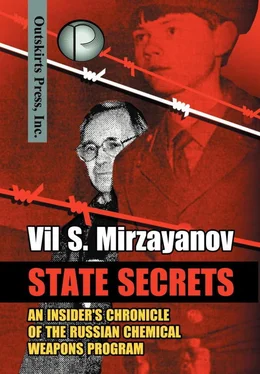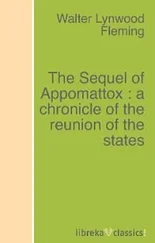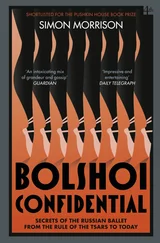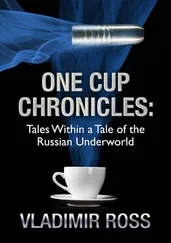The First Department was operating under the control of the Deputy Director of the Security Regime, a KGB officer who only formally was subordinate to Director of GOSNIIOKhT. The Second Department was also operating under the supervision of the Deputy Director of the Security Regime.
The Third Department was also operating under the control of Deputy Director of the Security Regime.
In the 1950s, the Soviet military directed the chemical weapons pipeline by controlling the research and development efforts, which took place at the Central Military Scientific Research Technical Institute in Moscow. At that time, GOSNIIOKhT was a civilian organization and its only military work was related to developing production technologies for the agents that the military’s central research institute discovered. In October 1960, Nikita Khrushchev, General Secretary of the Communist Party, decided that the research of chemical agents was too dangerous for a major metropolitan area and moved the Central Military Scientific Research Technical Institute to a town near the Volga River in southern Russia called Shikhany. Most of the military’s senior scientists, which included civilian as well as military researchers, were reluctant to relocate to Shikhany and instead “retired” to GOSNIIOKhT.
According to Western historians, there wasn’t any Tatar Yoke after the Tatar-Mongols were conquered at the beginning of 13th Century. The opposite is true: the Tatars are the real founders of the united Russian State. See, for instance, Donald Ostrowski , Muscovy and the Mongols. Cross-Cultural Influences on the Steppe Frontier, 1304-1589 (Cambridge, UK: Cambridge University Press, 1998); Boris Ischboldin , Essays on Tatar History . (New Delhi India: New Book Society of India, 1963); Janet Martin, Medieval Russia 980-1584 (Cambridge, UK: Cambridge University Press, 1995).
I.L. Knunyants, A.I. Shchekotikhin, A.V. Fokin, Izvestia AN SSSR , otdelenie khim.nauk, no. 2 (1953), p. 282-289.
Within seconds to minutes after exposure to a lethal dose of nerve agent by ingestion, skin exposure, or inhalation, a person will begin vomiting violently and go into seizures, eventually losing consciousness. Even when antidotes are available, these factors can make medical treatment much more difficult. U.S. Army Medical Research Institute of Chemical Defense, Medical Management of Chemical Casualties Handbook , 3rd ed. (Aberdeen Proving Ground, MD: Chemical Casualty Care Division, 1999): 105-37.
In 1974 the following people received the Lenin Prize for organizing the production of Substance 33: A.V. Fokin, K.A. Guskov, M.I. Kabachnik, Ju.V. Privezentsev, V.M. Romanov, V.F. Rostunov, E.M. Zhuravski. Like Kabachnik and Fokin, Zhuravski didn’t have any relationship to this work except that he had been the chief of a department of UNKhV.
The Administration of Chief of the Chemical Troops.
It is necessary to point out that the role of the VPK has been exaggerated in some literature sources. Its role overall was limited to distribution of funds, especially currency etc. Some people named it the fifth wheel of the car.
I’ll write further about Kirpichev’s discovery.
Oleg Vishnyakov, “Interview with a Noose Around the Neck”, Novoe Vremya, No 6, 1993, p. 40. (English version, Oct. 1993, p. 22-23.)
Count Grigory G. Orlov (1734-1783) was a lover of Empress Catherine II of Russia. In 1762 he organized the coup d’état that placed Catherine on the Russian throne and subsequently was her close adviser. John Alexander, Catherine the Great: Life and Legend (New York: Oxford Univ. Press, 1989): 56-7.
On the initial discovery, L.E. Tammelin, “Dialkoxy-phosphorylthiocholines, alkoxymethyl-phosphorthiocholines, and analogous choline esters,” Acta Chemica Scandinavica 11(1957): 1340-9. For a brief history of “V” agents, Stockholm International Peace Research Institute, The Problem of Chemical and Biological Warfare: A Study of the Historical, Technical Military, Legal, and Political Aspects of CBW and Possible Disarmament Measures, The Rise of CB Weapons , vol. 1 (New York: Humanities Press, 1971): 74-5.
See ref.13.
The Bigeye bomb was developed to mix diisopropyl aminoethylmethyl phosphonate with sulfur to make VX. Frederick R. Sidell, Ernest T. Takafuji, and David R. Franz, Medical Aspects of Chemical and Biological Warfare, Textbook of Military Medicine, Warfare, Weaponry, and the Casualty: Part I (Office of the Surgeon General: US Army 1997): 65-6, 70-1.
Di-isopropyl-aminoethylmethyl-phosphonate.
David Wise. Cassidy’s Run : The Secret Spy War Over Nerve Gas. (New York: Random House, 2000).
BZ is short for 3-Quinuclidinyl benzilate. BZ is an anticholinergic, a category of drugs that includes antihistamines, antidepressants, and antipsychotics. Depending on the dosage, the effects of BZ range from mild drowsiness to loss of coordination, dulled thought process, confusion, paranoia, delirium, and hallucination. These symptoms generally appear several hours after exposure to BZ and can last for up to 96 hours. For more information, see James Ketchum and Frederick R. Sidell, “Incapacitating Agents,” Textbook of Military Medicine , pp.296.
On Markov’s murder see, Richard H. Cummings, “The Murder of Georgi Markov,” Intelligencer 10, no. 1 (Feb. 1999): 9-11.
This facility was initially code named Tomko and worked in secrecy under a 1927 Russo-German pact to make chemical weapons. Not far from there, the so-called Tankodrom for training tank crews for German troops was located in Shikhany-1.
See ref. 82.
See Annex 5.
According to Kremlin spokesman Alexander Orofyonov, Kuntsevich was fired because of “a single grievous violation of his work responsibilities.” Alexander Gordeyev, “Yeltsin Fires Top Chemical Weapons Official,” The Moscow Times , 8 April 1994.
See ref. 56.
Resolution of Central Committee of the CPSU and Council of Ministers of USSR from April 24 1977 N 3509-123. See Annex 21.
The tests could have gone very well, but the old cholinesterase method of analysis that the scientists at Nukus used did not allow the results to be interpreted accurately.
Read about his “discovery” in Chap. 9.
Modeling was used to see how the agent would perform with other types of delivery systems.
The factory design was completed by NII Khimproject in Volgograd. GOSNIIOKhT deputy director Guskov told me about the planned move of A-230 production to Pavlodar, where a commercial chemical plant was already located. At that time, sarin and soman were being produced at the Volgograd plant, which is in a city. Decisions had been made to move chemical weapons production operations to this more remote location. Not only were multiple agents to be produced at Pavlodar, but also the plant’s production capability was to exceed that of Novocheboksarsk. For more on the Pavlodar plant, see Gulbarshyn Bozheyeva, “The Pavlodar Chemical Weapons Plant in Kazakhstan: History and Legacy,” Nonproliferation Review 7, no. 2 (Summer 2000): 136-45.
Читать дальше












